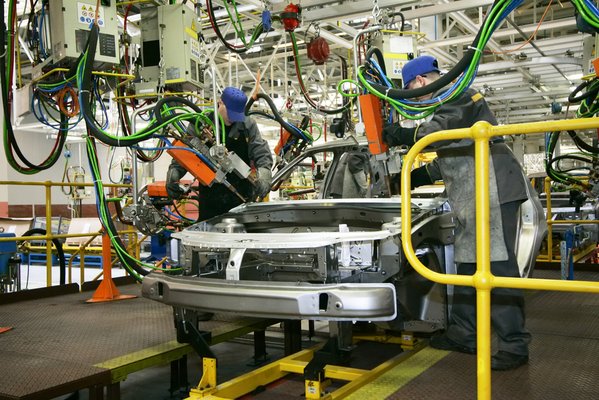The circular economy model is a description of economic systems that explicitly includes the recycling of material flows. It distinguishes itself from so-called linear material flows, i.e. the unidirectional process sequence of material extraction, production, distribution, use and disposal. Instead, loops are provided between different process stages in order to have to go through the energy-intensive steps of raw material extraction, material production and manufacturing less frequently for the same number of available products.
The principle of the circular economy as a component of the European Green Deal was given concrete form in the New Circular Economy Action Plan. With regard to the circularity of vehicles, the primary focus was on batteries and their valuable components, but end-of-life vehicles are addressed in their entirety in order to conserve resources and reduce waste by recycling materials. The industry in Europe, especially the automotive industry, is only just starting on this path, especially since the complexity to be mastered is enormous.
The initial situation in the present project is as follows: Automotive components from body and exterior contain high-quality, recyclable raw materials, but are only dismantled and recycled to a small extent today for reasons such as dismantling time or lack of market demand.
The current situation with regard to the recycling of end-of-life vehicles is regulated in Germany today by the End-of-Life Vehicles Ordinance of 18.11.2020. Even though 95% of a vehicle's weight must be properly recycled, most of it goes via the shredder for downcycling due to low material purity and does not meet the high quality requirements for reuse in new vehicles. As a rule, virgin materials are so inexpensive and disassembly times for most components so lengthy and expensive that, with the exception of a few components, dismantling and subsequent reprocessing for recycling is not worthwhile.
Until now, automotive suppliers have mainly relied on processing residues from industrial production for the use of recycled material and are already complaining about a lack of availability in relation to the growing demand for recycled material. Post-consumer material from end-of-life vehicles is hardly used. In the future, regulatory requirements to limit climate change at EU and national level will bring about growing recycling rates for raw materials used, and a rising CO2 price will make primary materials more expensive.
In order to achieve CO2 neutrality in Germany by 2045 at the latest, intensive efforts by industry are required. Achieving this goal will only be possible if the supply and value chains of the manufacturing industry consistently increase the secondary raw material quota drastically and thus realize closed material cycles. However, creating these is accompanied by major challenges: In addition to economic concepts for dismantling purely according to material type, which require identification and sorting of the components at the end of life of the vehicles, adapted pre- and post-shredding processes are also needed, in which questions arise above all with regard to suitable characterization, efficient separation and quality of the secondary materials suitable for automotive use.
Part of these challenges will be investigated in the Car2Car project and technological solutions to overcome them will be developed.
The main objective of the proposed project is therefore to enable and implement a circular economy for selected automotive material groups.
The project is divided into 7 work packages, spread over a total period of three years. After an initial clarification of requirements in work package 1, a circular-economy-optimized disassembly is designed and researched in work package 2. This work package is in the center of the activities of the chair fml in this research project: In addition to the development of an evaluation system for the disassembly decision of focused components, disassembly technologies are also evaluated and then implemented for a selected use case demonstrator. In addition, reverse logistic design guidelines are developed and information logistic integration is performed. In contrast, in work package 3, mechanical processing for the Circular Economy is being promoted by shredding and further processing of the vehicles. For this purpose, a sensor-based sorting system for different scrap fractions will be developed in work package 4. The two subsequent work packages focus on individual material groups and examine them with regard to existing requirements, quality assessment benchmarks and strategies for overcoming Circular Economy-related challenges: Steel (work package 5) and Glass (work package 6). Work package 7 will conclude with an ecological and economic evaluation of the concepts developed.
Current Topics
Car2Car in the media -- at the following addresses you will find press reports that have already appeared on our research project:
www.recyclingmagazin.de/2023/04/21/technologien-fuer-optimiertes-altfahrzeugrecycling/
- BMW AG
- Aurubis AG
- Helmholtz Institut HZDR-HIF
- Novelis Deutschland GmbH
- Oetinger Aluminium GmbH
- Pilkington Automotive Deutschland GmbH
- Salzgitter Mannesmann Forschung GmbH
- Scholz Recycling GmbH
- Steinert UniSort GmbH
- thyssenkrupp Steel Europe AG
- TU Bergakademie Freiberg, Institut IGT
- TU Bergakademie Freiberg, Institut MVTAT
- TU Bergakademie Freiberg, Institut IEST
- Technische Universität München, Professur für Circular Economy
- Technische Universität München, Institut für Werkzeugmaschinen und Betriebswissenschaften
The research project is funded by the German Federal Ministry of Economics and Climate Protection with the grant number 19S22007H.
